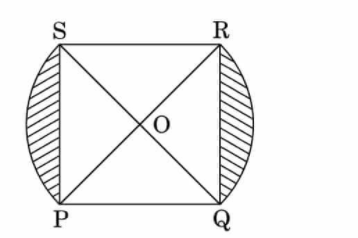In Figure, two circular flower beds have been shown on two sides of a square lawn ABCD of side 56m. If the centre of each circular flower bed is the point of intersection of the diagonals of the square lawn, find the sum of the areas of the lawns and the flower beds.
To solve the problem, we will follow these steps:
Step 1: Calculate the area of the square lawn.
The area of a square is given by the formula:
Area of square=side2
Given the side of the square lawn ABCD is 56 m, we calculate:
Area of square=562=3136m2
Step 2: Determine the radius of the circular flower beds.
The center of each flower bed is at the intersection of the diagonals of the square. The diagonals of a square bisect each other at right angles. The length of the diagonal d of the square can be calculated using the formula:
d=√2×side
Calculating the diagonal:
d=√2×56=56√2m
Since the radius r of each flower bed is half of the diagonal:
r=d2=56√22=28√2m
Step 3: Calculate the area of one circular flower bed.
The area A of a circle is given by the formula:
A=πr2
Substituting the radius:
A=π(28√2)2=π×784×2=1568πm2
Using π≈227:
A≈1568×227≈4950.86m2
Step 4: Calculate the total area of both flower beds.
Since there are two flower beds, the total area of the flower beds is:
Total area of flower beds=2×1568π≈2×4950.86≈9901.72m2
Step 5: Calculate the sum of the areas of the lawn and the flower beds.
Finally, we add the area of the square lawn to the total area of the flower beds:
Total area=Area of lawn+Total area of flower beds
Total area=3136+9901.72≈13037.72m2
Final Result
The sum of the areas of the lawns and the flower beds is approximately:
Total area≈13037.72m2
---
The area of a square is given by the formula:
Area of square=side2
Given the side of the square lawn ABCD is 56 m, we calculate:
Area of square=562=3136m2
The center of each flower bed is at the intersection of the diagonals of the square. The diagonals of a square bisect each other at right angles. The length of the diagonal d of the square can be calculated using the formula:
d=√2×side
Calculating the diagonal:
d=√2×56=56√2m
Since the radius r of each flower bed is half of the diagonal:
r=d2=56√22=28√2m
The area A of a circle is given by the formula:
A=πr2
Substituting the radius:
A=π(28√2)2=π×784×2=1568πm2
Using π≈227:
A≈1568×227≈4950.86m2
Since there are two flower beds, the total area of the flower beds is:
Total area of flower beds=2×1568π≈2×4950.86≈9901.72m2
Finally, we add the area of the square lawn to the total area of the flower beds:
Total area=Area of lawn+Total area of flower beds
Total area=3136+9901.72≈13037.72m2
The sum of the areas of the lawns and the flower beds is approximately:
Total area≈13037.72m2
Topper's Solved these Questions
Similar Questions
There are two circular flower beds on two sides of a square lawn ABCD of side 56 m. If the centre of each circular flower bed is the point of intersection of the diagonals of the square lawn, find the sum of the areas of the lawn and the flower beds.
View SolutionIt is proposed to add to a square lawn measuring 58cm on a side, two circalar ends. The centre of each circle is the point of intersection of the diagonals of the square. Find the area of the whole lawn.
View SolutionIn the following figure, PQRS is square lawn with side PQ = 42 metres. Two circular flower beds are there on the sides PS and QR with centre at O, the intersections of its diagonals. Find the total area of the two flower beds (shaded parts).

View SolutionFind mutual inductance if we have a square loop of side r instead of a small circular loop of side r at the centre of bigger circular loop.
View SolutionThe side of a square exceeds the side of the another square by 4 cm and the sum of the areas of the two squares is 400 sq. cm. Find the dimensions of the squares.
View SolutionA circular flower bed takes up half the area of a square lawn. If an edge of the lawn is 200 feet long, what is the radius of the flower bed? (Express the answer in terms of π.)
View SolutionIf the perimeter of a rectangular flower bed is 30 feet, and its area is 44 square feet, what is the length of each of its shorter sides?
View SolutionA rectangular flower bed is 7 m long. If the boundary around the bed is 22 m long, find its breadth. Also, find its area.
View SolutionA square is drawn by joining the mid-points of the sides of a square. A third square is drawn inside the second square in the same way and the processes continued indefinitely. If the side of the square is 10cm , find the sum of the areas of all the squares so formed.
View SolutionA circular flower bed is surrounded by a path 4m wide. The diameter of the flower bed is 66m. What is the area of this path ? (π=3.14)
View Solution
